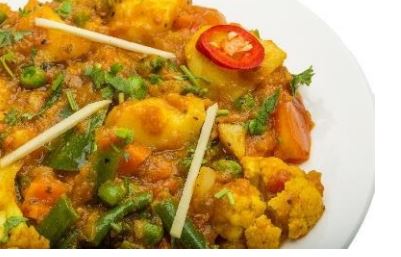Serves: 6
INGREDIENTS:
- Curry Paste
- 3 cups peeled, chopped squash
- 2 cups thick coconut milk
- 3 tbsp. coconut oil
- 2 tbsp. raw honey
- 2 pounds tomatoes
- 1 and 1/4 cup brown rice, uncooked
- 1 cup chopped cauliflower
- 1 cup chopped green peppers
- Cilantro for topping
INSTRUCTIONS:
- Cook Brown Rice: Prepare the brown rice according to the package instructions or your preferred method. Once cooked, set it aside.
- Make Curry Paste: In a skillet or large saucepan, pour the thick coconut milk. Mix in the curry paste and raw honey into the coconut milk until well combined.
- Add Vegetables: Add the chopped cauliflower, squash, and green peppers to the coconut milk mixture. Cover the skillet and let the vegetables simmer until the squash becomes tender. This will take about 10-15 minutes, depending on the size of the squash pieces.
- Thicken Sauce: After simmering, remove the skillet from the heat and let it stand for about 10 minutes. The sauce will naturally thicken during this time.
- Serve: To serve, spoon the curry over the cooked brown rice. Garnish with chopped cilantro on top for added freshness and flavor.
ALLERGIES:
SF (Shellfish-Free)
GF (Gluten-Free)
DF (Dairy-Free)
EF (Egg-Free)
NF (Nut-Free)
V (Vegetarian)
Here are some variations of the squash and coconut curry recipe:
1. Protein Variations:
- Chicken Curry: Add cooked and diced chicken to the curry to make it a chicken and squash curry.
- Shrimp Curry: Incorporate cooked and peeled shrimp into the curry for a delightful seafood twist.
- Tofu Curry: For a vegetarian option, use firm tofu instead of meat. Cut the tofu into cubes and add it to the curry during the simmering process.
2. Vegetable Variations:
- Sweet Potato Curry: Replace the squash with sweet potatoes for a slightly sweeter flavor and hearty texture.
- Eggplant Curry: Include chopped eggplant in the curry to add a rich and meaty element to the dish.
- Spinach Curry: Add fresh spinach leaves towards the end of the cooking process for a nutrient-packed and vibrant green curry.
3. Spice Level and Flavors:
- Spicy Curry: Increase the amount of curry paste and crushed red pepper for a spicier version.
- Mild Curry: Reduce or omit the crushed red pepper for a milder and more family-friendly option.
- Thai Green Curry: Use green curry paste and add Thai basil and lime leaves for an authentic Thai twist.
4. Grain Alternatives:
- Quinoa: Replace the brown rice with cooked quinoa for a protein-rich and gluten-free option.
- Cauliflower Rice: For a low-carb alternative, serve the curry over cauliflower rice.
5. Creaminess and Dairy:
- Cashew Cream: Stir in cashew cream or coconut cream for added creaminess and richness.
- Yogurt: Top the curry with a dollop of plain yogurt or Greek yogurt for a tangy finish.
6. Nutty Flavors:
- Coconut Flakes: Garnish the curry with toasted coconut flakes for added texture and coconut flavor.
- Crushed Peanuts: Sprinkle crushed peanuts on top for a delightful nutty crunch.
7. Lentil Curry: Add cooked lentils, such as red or green lentils, to the curry to boost protein and fiber content. Lentils will also add a hearty and earthy flavor to the dish.
8. Chickpea Curry: For a delicious and filling vegetarian option, include cooked chickpeas in the curry. Chickpeas add a creamy texture and nutty taste.





